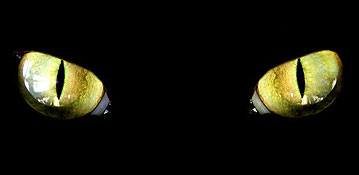LONDON, Dec. 1, 2008 – Recent research into the development of invisibility devices has spurred two physicists to investigate the process by which the behavior of light overcomes the seemingly intractable problem of optical singularities.
According to these physicists, this could soon lead to the manufacturing of a perfect cat's eye.
Unlike humans, cat’s eyes appear to glow in the dark because of their ability to reflect light from all directions. They are effective because they can send light back from where it came, but while this works well for light from some angles, it doesn’t work well for all.
When light is shone through a glass of water with a straw in it, for example, it appears as though the straw is bent. This is because the speed of light has been affected by the obstruction of the glass and the water. Physicists measure the effect that materials have on light using the refractive index, with 1 as the speed of light unobstructed in air, and approximately 1.5 as the point on the index when light meets glass and water.
However, when materials forces light down to zero or shoots it up to infinity on the refractive index, this process is called optical singularities, which have long been thought impossible to produce. It is this very process that physicists need to understand to create a material that can reflect light from all directions and thereby create the perfect cat's eye.
Ulf Leonhardt of St Andrew's University and Tomás Tyc of Masaryk University in the Czech Republic use ideas from one of the latest trends of optics called transformation optics to transmute the infinity mark on the refractive index into something more practical. Put simply, the scientists have developed a recipe of materials to create optical illusions – some can be used for invisibility devices, others to make things perfectly visible.
"Our method works for optical singularities which are the curse of physics, often seeming intractable, but we have found a way of transmuting optical singularities with just harmless crystal defects as a side-effect," said Tyc and Leonhardt in a research paper published in a New Journal of Physics' focus issue 'Cloaking and Transformation Optics.'
Applications will probably first appear in wireless technology and radar, for electromagnetic microwaves instead of light, because the required materials for electromagnetic microwaves are easier to manufacture.
Leonhardt and Tyc's findings appear alongside other scientists' work in the focus issue where scientists have developed recipes for other optical illusions where physical space appears to be transformed, for example for making invisibility devices.
For more information, visit: www.ipo.org